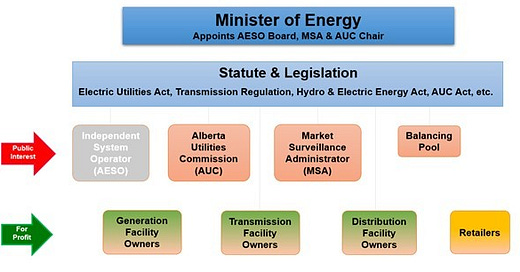The intent of this article is to provide a high-level overview of Alberta’s electricity industry structure. Links are provided below for readers who would like to learn more about the various industry actors.
Alberta “deregulated” its electricity industry in 1996. The generation of electricity and its sale to consumers (the supply of electricity) was deregulated and opened to market competition, while the transmission and distribution of electricity (the transportation of electricity) remained regulated. The rationale for regulating transmission and distribution infrastructure is that these are natural monopolies that are a public good and allowing competition in these areas would not be economically efficient. This is the industry structure we have in Alberta today.
This structure means that power generation assets (coal and gas fired power plants, wind turbines, hydroelectric power plants, etc.) are owned by private companies that earn all of their revenues through competitive electricity markets (an “energy only” electricity market and an ancillary services market in Alberta) or through contractual commercial arrangements. The electricity markets are governed by market rules and environmental regulations. Transmission and distribution assets are also owned by private companies, but they are regulated by the Alberta Utilities Commission, which means the companies that own these assets earn their revenues by recovering their capital expenditures and operating costs from ratepayers governed by regulatory processes.
In addition to our market approach, there are two key aspects of our structure that differentiate Alberta from other Canadian provinces:
There are no provincial government owned power generation, transmission, or distribution companies in Alberta – all power system infrastructure in Alberta is investor owned.
There is no integrated planning of generation and transmission system infrastructure in Alberta. Generation Facility Owners independently plan their own new power generation facilities based on economics and the AESO plans the transmission system based on demand forecasts and assumptions on when, where, and what type of power generation facilities may be built in the future. In other provinces, such as Saskatchewan and Manitoba, the provincially owned vertically integrated utilities like SaskPower and Manitoba Hydro (crown corporations), perform integrated resource planning, which optimizes between transmission and generation to meet forecast demand and determines the timing, location, and type of new power generation facilities. In Alberta, the AESO is only responsible for transmission planning and does not control the timing, location, or type of power generators built in Alberta as these decisions are made by the generation facility owners.
The following are the key entities in the Alberta electricity industry and a brief description of their roles:
Creates electricity policy and writes policy into law (statutes and regulations)
Independent System Operator (ISO known as the Alberta Electric System Operator)
Independent public agency, not for profit
Plans and operates the transmission system and electricity markets
Duties and obligations specified in the Electric Utilities Act and Transmission Regulation
Alberta Utilities Commission (AUC)
Independent regulatory body
Duties specified in the Alberta Utilities Commission Act
Approves need for new transmission, construction and operation of new power plants, transmission facilities and distribution facilities, and tariffs for cost recovery (AESO, TFOs, DFOs)
Market Surveillance Administrator (MSA)
Independent market monitoring and enforcement agency
Provides oversight of electricity and natural gas markets
Mandate and obligations specified in the Alberta Utilities Commission Act and various Regulations
Independent corporation, not a public agency
Originally created to manage unsold Power Purchase Agreements (PPAs) at the start of deregulation as well as various other market related matters
Allocates any net revenue or net expenses to market participants via the ISO Tariff
Duties and obligations specified in the Electric Utilities Act and the Balancing Pool Regulation
Generation Facility Owners (GFOs)
Investor owned, for profit entities
Plan, build, own and operate power plants
Sell electricity and ancillary services via the wholesale electricity market
ENMAX Energy, TransAlta, and Capital Power are examples of GFOs
Transmission Facility Owners (TFOs)
Investor owned, for profit entities
Build, own and operate transmission facilities
Regulated cost recovery via a tariff
AltaLink, ATCO, and ENMAX Power are examples of TFOs
Distribution Facility Owners (DFOs)
Investor owned, for profit entities
Build, own and operate distribution facilities
Regulated cost recovery via a tariff
Fortis and ENMAX Power are examples of DFOs
Retailers
Investor owned, for profit entities
Sell electricity to consumers – homes and businesses
ATCO, ENMAX Energy, and Direct Energy are examples of retailers
For a more comprehensive overview of what I’ve described in this article, the AESO publishes an excellent Guide to Understanding Alberta’s Electricity Market that I recommend for those who want to learn more.




